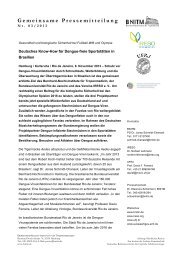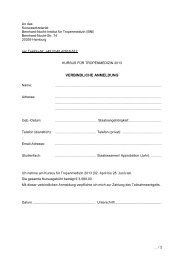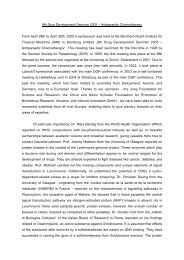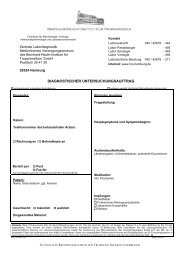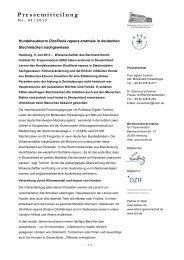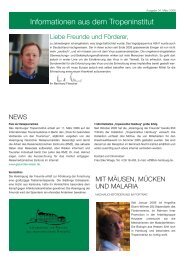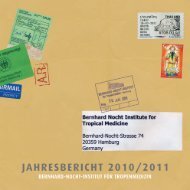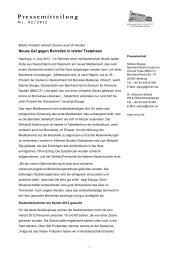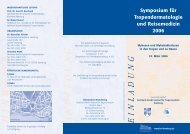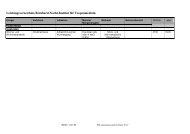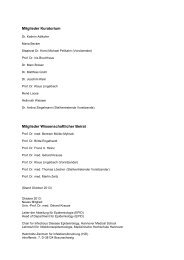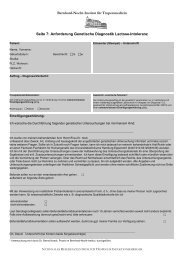Research Group Heussler (Malaria I) - Bernhard-Nocht-Institut für ...
Research Group Heussler (Malaria I) - Bernhard-Nocht-Institut für ...
Research Group Heussler (Malaria I) - Bernhard-Nocht-Institut für ...
Create successful ePaper yourself
Turn your PDF publications into a flip-book with our unique Google optimized e-Paper software.
Project Description and Results<br />
AdoMetDCs are highly regulated at the transcriptional,<br />
at the translational as well as at the posttranslational<br />
level. The catalytic activity of mammalian AdoMetDC,<br />
e.g., is stimulated by putrescine which is thought to be<br />
a regulatory mechanism to relate putrescine abundance<br />
with the synthesis of higher polyamines in order<br />
to avoid unbalanced consumption of S-adenosylmethionine.<br />
AdoMetDCs from the nematodes O. volvulus and<br />
C. elegans resemble to a large extent the biochemical<br />
and biophysical properties of their mammalian counterparts.<br />
However, while the human AdoMetDC exhibits a<br />
high basic activity even in the absence of the activator<br />
putrescine, both nematode enzymes are nearly inactive<br />
under these conditions (Figure 1). We conclude that<br />
they highly depend on an activator to achieve significant<br />
catalytic activity. Accordingly, activation of the C.<br />
elegans and O. volvulus AdoMetDC by putrescine is<br />
much more pronounced (maximal 350- and 63-fold, respectively)<br />
than of the human enzyme (maximal 3-fold).<br />
Moreover, the human AdoMetDC responses exclusively<br />
to putrescine. In contrast to that, the enzymatic activity<br />
of the nematode AdoMetDC increases also in the presence<br />
of a number of other polyamines including the<br />
naturally occuring spermidine and spermine (Figure 1).<br />
The recently resolved crystal structure of the human<br />
AdoMetDC revealed the topology of the putrescinebinding<br />
site responsible for the putrescine stimulation.<br />
Interestingly, the amino acid residues that were found<br />
to be involved in putrescine binding are well conserved<br />
in the nematode enzymes despite their lower specificity<br />
for stimulator molecules. Mutagenic studies indicate that<br />
at least three of these residues most likely also contribute<br />
to activator binding of C. elegans AdoMetDC. Furthermore,<br />
the C. elegans AdoMetDC mutant Glu 194Gln<br />
has a 100-fold enhanced basic activity in the absence<br />
of any stimulator, suggesting that this mutant protein<br />
mimics the conformational change naturally induced by<br />
activator molecules.<br />
Figure 2: Synthetic polyamine analogue BW-1 evaluated for<br />
inhibitory activity against O. volvulus, C.elegans and human<br />
AdoMetDC in vitro.<br />
Usually, AdoMetDCs are translated as pro-proteins, that<br />
are subsequently cleaved by an autocatalytic process<br />
resulting in a heteroterameric enzyme complex. Both<br />
recombinantly expressed nematode AdoMetDC are<br />
correctly posttranslationally processed in Escherichia<br />
coli resulting in the formation of a small β- and a large<br />
α-subunit. Mutations of amino acid residues that are<br />
part of the putative activator binding site affect this<br />
cleavage step, indicative for a putrescine responsiveness<br />
of this process like it has been reported also for<br />
mammalian AdoMetDC.<br />
37<br />
Parasitology Section<br />
As shown above, at least two features distinguish nematode<br />
AdoMetDCs from their mammalian counterparts.<br />
First, the unstimulated enzyme exhibits a very low specific<br />
activity. Second, its polyamine binding pocket has<br />
a lower specificity for activator binding. To examine if<br />
these differences might be exploitable to specifically inhibit<br />
nematode AdoMetDC activity, we looked for polyamine<br />
analogues that bind to the pocket but do not stimulate<br />
the enzyme. The effects of several new polyamine<br />
analogues were tested on the O. volvulus, C. elegans<br />
and human AdoMetDC activity. Tetramines with a 3-7-3<br />
backbone and terminal bulky ring systems like BW-1<br />
(Figure 2) do not stimulate nematode AdoMetDC. On the<br />
contrary, they reduce the basic activity of the unstimulated<br />
AdoMetDCs and, in addition, have an inhibitory effect<br />
on the maximal stimulated enzymes (Table 1). At<br />
this, both nematode enzymes are generally more sensitive<br />
than the human AdoMetDC. Future studies will elucidate<br />
whether the found unspecificity of nematode<br />
AdoMetDCs towards stimulator molecules may be exploitable<br />
for the development of novel chemotherapeutic<br />
agents (polyamine analogues) against nematodes.<br />
O. volvulus C. elegans H. sapiens<br />
Addition Specific activity<br />
2 mM [nmol min-1 mg-1]<br />
Putrescine 79 ± 3 240 ± 24 410 ± 34<br />
Putrescine<br />
+ BW-1<br />
0.3 ± 0.1 0.5 ± 0.4 63 ± 6<br />
Table 1: Inhibition of putrescine-stimulated O. volvulus, C. elegans<br />
and human AdoMetDC by the polyamine analogue BW-1.<br />
Specific activities were determined under standard assay conditions<br />
in the presence of 2 mM putrescine with or without the<br />
addition of 2 mM of the polyamine analogue. Results are given<br />
as the mean (± SD) of at least three independent duplicate determinations.<br />
Selected Publications<br />
• Ndjonka D et al. (2003) Biol Chem 384: 1195-201<br />
• Ndjonka D et al. (2003) Biol Chem 384: 83-91<br />
Funding<br />
• Deutsche Forschungsgemeinschaft<br />
• Deutscher Akademischer Austauschdienst<br />
Cooperating Partners<br />
• P. Woster, Wayne State University, Detroit, USA<br />
• A. Da’dara, Harvard School of Public Health, Boston,<br />
USA<br />
Investigators<br />
• Kai Lüersen<br />
• Dieudonné Ndjonka<br />
• Rolf D. Walter



